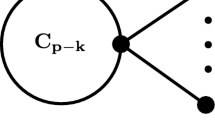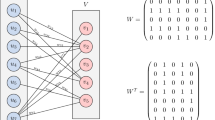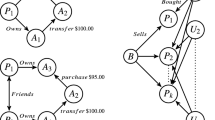Abstract
Identification of isomorphism among graphs is one of the computationally challenging tasks in computer science that couldn’t be solved in polynomial time. In this paper, we derive a polynomial time algorithm that allows direct comparison between different graph structures to check for graph isomorphism. This paper suggest to represent graphs in a common mathematical space (Symmetric Positive Semi-Definite space), so that two isomorphic graphs always map to the same coordinates in a mathematical space. This kind of mathematical representation is generated based on the neighbourhood influences between nodes of a graph which enhances the graph topological structure at the node level in the form of krylov subspace, in polynomial time. Experiments are conducted using publicly available benchmark graph database. From the simulation, it is observed that the representation recommended in this work acts like a signature for each graph with guaranteed isomorphism. Further the proposed approach tries to identify the molecular structure of any application-specific graphs and categorizes them effectively in a polynomial time inspite of its NP-completeness.







Similar content being viewed by others
References
Pelillo M (1999) Replicator equations, maximal cliques, and graph isomorphism. Neural Comput 11(8):1933–1955
Conte D, Foggia P, Sansone C, Vento M (2004) Thirty years of graph matching in pattern recognition. Intl J Patt Recog Art Intel 18(3):265–298
Pinheiro MA, Kybic J (2016) Geometric graph matching using monte carlo tree search. IEEE Trans Patt Anal Mach Int
Gori M, Maggini M, Sarti L (2005) Exact and approximate graph matching using random walks. IEEE Trans Patt Anal Mach Int 27(7)
Tuzel O, Porikli F, Meer P (2006) Region covariance: a fast descriptor for detection and classification. Proc European Conf Comput Vis
Porikli F, Tuzel O (2006) Covariance tracker. Proc IEEE Conf Comput Vis Patt Recogn
Pang Y, Yuan Y, Li X (2008) Gabor-Based Region Covariance Matrices for Face Recognition. IEEE Trans Circ Syst Video Technol 18(7):989–993
Ullmann, Julian R (2010) Bit-vector algorithms for binary constraint satisfaction and subgraph isomorphism. J Exp Algorith
Aho AV, Hopcroft JE, Ullman JD (1974) The design and analysis of computer algorithms. Add Wesley
Hopcroft JE, Wong J (1974) Linear time algorithm for isomorphism of planar graphs. Proc 6th Ann ACM Symposium Theory Comput 172–184
Dickinson PJ, Bunke H, Dadej A, Kraetzl M (2004) Matching graphs with unique node labels. Pattern Anal Applic 7(3):243–254
Jiang X, Bunke H (1999) Optimal quadratic-time isomorphism of ordered graphs. Pattern Recogn 32(17):1273–1283
Luks EM (1982) Isomorphism of graphs of bounded valence can be tested in polynomial time. J Comput Syst Sci 25(1):42–65
Cordella LP, Foggia P, Sansone C, Vento M (1999) Performance evaluation of the vf graph matching algorithm. Proc. 10th Int’l Conf Image Anal Proc 1172–1177
Cordella LP, Foggia P, Sansone C, Vento M (2004) A (sub)graph isomorphism algorithm for matching large graphs. IEEE Trans Patt Anal Mach Intel 26(20):1367–1372
Messmer BT, Bunke H (1999) A decision tree approach to graph and subgraph isomorphism detection. Pattern Recogn 32(12):1979–1998
He H, Singh AK (2008) Graphs-at-a-time: query language and access methods for graph databases. SIGMOD-08 405–418
Zhang S, Li S, Yang J (2009) GADDI: distance index based subgraph matching in biological networks. EDBT 192–203
Zhao P, Han J (2010) On graph query optimization in large networks. PVLDB 3(1):340–351
Ambauen R, Fischer S Bunke H (2003) Graph edit distance with node splitting and merging and its application to diatom identification. In Proc 4th Intl. workshop on Graph Based Representations in Pattern Recognition, LNCS 2726, Springer. 95–106
Cherian A, Sra S, Banerjee A, Papanikolopoulos N (2013) Jensen- Bregman LogDet divergence with application to efficient similarity search for covariance matrices. IEEE Trans Patt Anal Mach Intel 35(9)
Querido T, Loiola EM, De Abreu NM, Boaventura-Netto PO, Hahn P (2007) A survey for the quadratic assignment problem. EJOR 657–690
Hyuk Cha S (2007) Comprehensive survey on distance / similarity measures between probability density functions. Int J Math Model Methods Appl Sci 1(4):300–307
De Jong KA, Spears WM (1989) Using genetic algorithm to solve NP-complete problems. Proc Int’l Conf Genet Algorithms 124–132
Aalo Y, Bronstein A, Kimmel R (2015) On convex relaxation of graph isomorphism. Proc Ntnl Acad Sci 112(10):2942–2947
Shrivastava A, Li P (1996) A new space for comparing graphs. IEEE/ ACM Intl Conf Adv Soc Netw Anal Mining
Wang J, Wang H, Zhou Y, McDonald N (2015) Multiple Kernel Multivariate Performance Learning Using Cutting Plane Algorithm IEEE Intl Conf on Syst Man Cybernet 187–1875
Yang X, Yu Q, He L, Guo T (2013) The one-against-all partition based binary tree support vector machine algorithms for multi-class classification. Neurocomputing 113:1–7
Aflalo Y, Brezis H, Kimmel R (2015) On the optimality of shape and data representation in the spectral domain. SIAM J Imaging Sci 8(2):1141–1160
Li Z, Liu J, Tang J (2015) Robust Structured Subspace Learning for Data Representation. IEEE Trans Pattern Anal Mach Intell 37(10):2085–2098
Krylov AN (1931) On the numerical solution of equations whose solution determine the frequency of small vibrations of material systems
Arsigny V, Fillard P, Pennec X, Ayache N (2006) Log-Euclidean Metrics for Fast and Simple Calculus on Diffusion Tensors. Magn Reson Med 56(2):411–421
Van Loan CF, Golub GH (1996) Matrix Computations, Third ed. Johns Hopkins Univ Press
Foggia P, Sansone C, Vento M (2001) A Database of Graphs for Isomorphism and Subgraph Isomorphism Benchmarking. Proc Third IAPR TC-15 Int’l Workshop Graph-Based Represent Patt Recogn 176–187
Riesen K, Bunke H (2008) IAM graph database repository for graph based pattern recognition and machine learning. SSPR
Author information
Authors and Affiliations
Corresponding author
Rights and permissions
About this article
Cite this article
Ramraj, T., Prabhakar, R. Influence of Krylov subspace in Graph Isomorphism for Mobile Networks. Mobile Netw Appl 24, 407–419 (2019). https://doi.org/10.1007/s11036-017-0914-x
Published:
Issue Date:
DOI: https://doi.org/10.1007/s11036-017-0914-x




